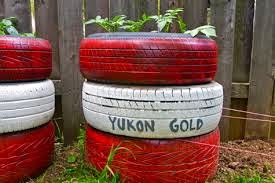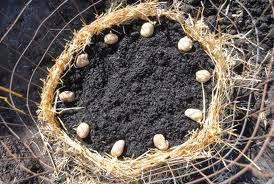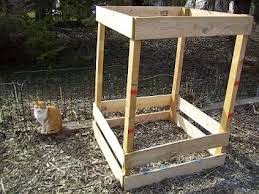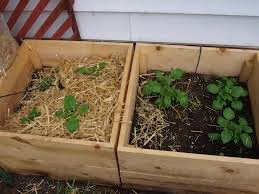Here’s a nugget ‘o wisdom I gleaned from the NW Flower and Garden Show last weekend in Seattle courtesy of Danielle Sherry, senior editor of Fine Gardening magazine. She presented on “Towering Tubers: Grow 20 Pounds of Spuds in Less than 4 Square Feet”, and I almost skipped it because of a preconceived notion I had about potato towers.
I had seen scores of takes on what I’ll call the Ever-Higher Potato Tower, which basically starts at ground level and adds units. Old tires used to be the classic building module, but now that’s passe due to greater awareness of the toxins they release.
 |
| Hey, I know what those red things are…they’re tires! Somewhat counterproductive to be growing healthy food in unhealthy containers. |
These days I’m seeing more stylish cedar boxes and such. The basic idea is that the plant is an indeterminate growing unit, and that a gardener can continue to coax the plant to grow more tubers by burying top growth from time to time. As the greens develop, Mr. or Ms. Gardener adds another box and a quantity of straw, soil, or compost, leaving a few leaves showing to power the plant to greater growth. This is repeated many times during the season. Finally, at the end of the season, when the plant is spent from working so hard to surmount the innumerable entombings the gardener has forced upon it, the tower is disassembled and, in a garden surface area of merely a few square feet, a mountain of potatoes tumbles out and a small village is kept from starvation. I have tried the technique with mixed results, never quite feeding as large a village as I would have liked, so that’s probably what motivated me to go to the talk, even though I thought I would be hearing things that I already knew.
Score one for humility. Because I parked my butt in the chair, I wound up getting an appealingly different take on the age-old tower. Sherry’s method is a one-time construction that forms a kind of green sculpture in the garden (until die-back, that is, when it might get a bit ugly). Within a sturdy cage made of reinforcing wire, which she suggested be about 4 feet tall and 1.5 feet in diameter, one adds alternating layers of straw and compost, basically 6″ of straw and 12″ of compost in each layer. Each layer of straw, beginning with the base, curves up a bit at the edges, like a nest, so it keeps the soil from spilling out of the cage.
 |
| What funny bird lays its eggs around the edge of the nest? |
On top of each soil layer go the potatoes, but not all over…only around the edges. There’s the brilliance. They grow out through the mesh cage and then obscure it with their greenery. When one gets to the top a final layer of potatoes is added and that layer is distributed evenly across the whole circle because that will form its green top. Potato “seeds” are distributed about 6″ apart from each other around the circumference and across the top. Key to making this thing thrive is incorporating a water source right in the tower. Sherry recommended spiraling a soaker hose along the inside of each potato ring and having the extra curl around the top. Her own experiences with the vagaries of hand watering (and consequent low yields) led her to recognize that steady, consistent watering were key to great production. I couldn’t agree more. Large forms like this can dry out in the middle and shed the water that is poured on from top. The cruel irony is that while the thing appears to be absolutely soaked, the inside may be parched.
Sherry estimates using one bale of straw (please, get straw, not hay!) and about 5 bags of potting soil. This initial investment becomes a rich garden amendment at the end of potato growing. Obviously with this system one uses more seed potato than with the box system, but what’s appealing for me is that it’s created in a few hours and needs no more tending. Also you don’t get something that looks like this in your garden for half a season.
 |
| What is my neighbor building? Giant box kite, shipping container, carnival dunking booth? |
My next post will continue the potato tower theme, and I’ll give my suggestions for how Ms. Sherry might supersize her 20 pound yield.


